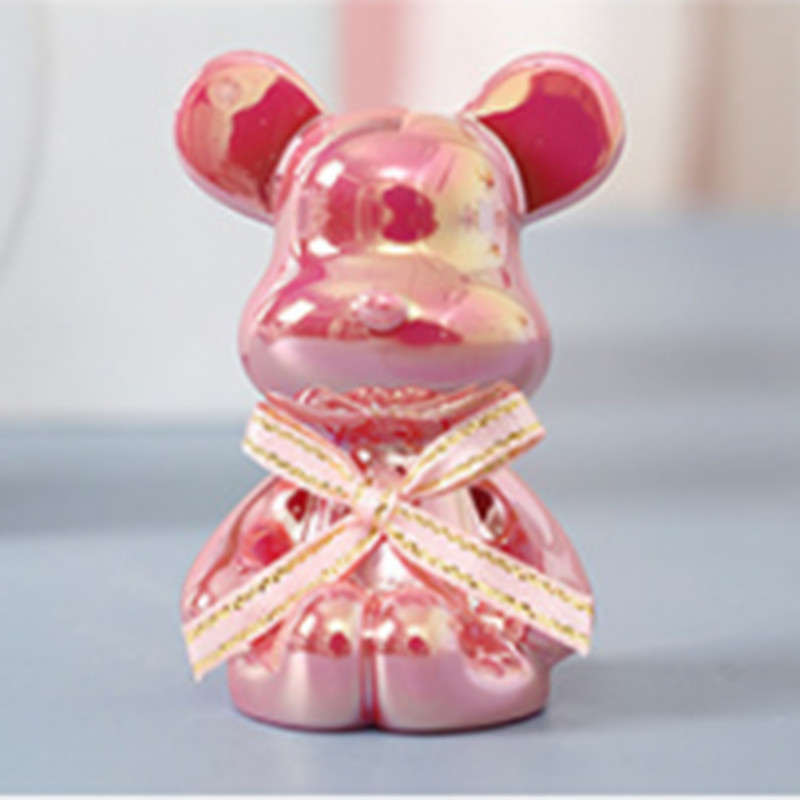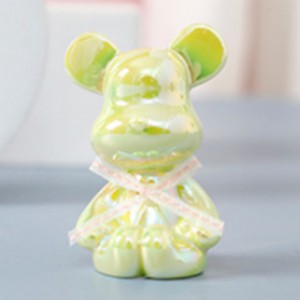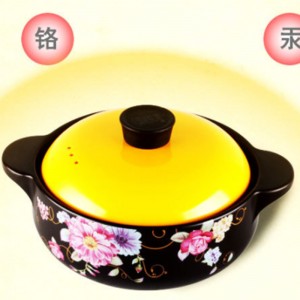Garage Kit, anime, figure, 3D Printed Figure
Workflow
| Reference price | 0.5-5USD |
| Make less orders | 500PCS |
| Delivery date | 5 days delivery |
| OEM | OK |
| Place of production | made in China |
| other | Including packaging |
Injection molding process is a complex processing process involving many factors, such as mold design, mold manufacturing, raw material characteristics and raw material pretreatment methods, molding process, injection molding machine operation, and is closely related to processing environmental conditions, product cooling time and post-treatment process.
Today, let's talk about the properties and process characteristics of common raw materials for injection molding:
ABS (super non breaking glue)
ABS performance:
ABS is synthesized from butadiene, acrylonitrile and styrene. Each monomer has different characteristics: butadiene has toughness and impact resistance; High thermal and chemical stability of acrylonitrile; Styrene has easy processing, high finish and high strength. In terms of morphology, ABS is an amorphous material with high mechanical strength and good comprehensive properties of "hardness, toughness and steel". It is an amorphous polymer. ABS is a general-purpose engineering plastic with various varieties and wide applications. It is also called "general-purpose plastic" (MBS is called transparent ABS). ABS is easy to absorb moisture, with a specific gravity of 1.05g/cm3 (slightly heavier than water), low shrinkage (0.60%), stable size and easy to form and process. The characteristics of ABS mainly depend on the ratio of three monomers and the molecular structure in the two phases. This can have great flexibility in product design, and thus produce hundreds of ABS materials of different quality in the market. These different quality materials provide different characteristics, such as medium to high impact resistance, low to high finish and high temperature distortion. ABS material has super workability, appearance characteristics, low creep, excellent dimensional stability and high impact strength. ABS is a light yellow granular or bead opaque resin, non-toxic, tasteless and low water absorption. It has good comprehensive physical and mechanical properties, such as excellent electrical properties, wear resistance, dimensional stability, chemical resistance and surface gloss, and is easy to process and shape. The disadvantages are weather resistance, poor heat resistance and flammability.
Process characteristics of ABS:
a: ABS has high moisture absorption and humidity sensitivity. Before molding, it must be fully dried and preheated (at least 2 hours at 80 ~ 90C) to control the moisture content below 0.03%.
b: The melting viscosity of ABS resin is less sensitive to temperature (different from other amorphous resins). Although the injection temperature of ABS is slightly higher than that of PS, it cannot have a loose heating range like PS. the method of blind heating cannot be used to reduce its viscosity. The fluidity can be improved by increasing the screw speed or injection pressure. Generally, the processing temperature should be 190-235 ℃
c: The melting viscosity of ABS is medium, higher than that of PS, hips and as, so it is necessary to use beer with higher injection pressure (500 ~ 1000bar)
d: ABS material adopts medium and high injection speed, and the effect of beer is better. (unless the shape is complex and thin-walled parts need high injection speed), gas lines are easy to occur at the nozzle of the product
e: ABS molding temperature is relatively high, and its mold temperature is generally adjusted at 25-70 ℃. When producing large products, the temperature of fixed mold (front mold) is generally about 5 ℃ higher than that of moving mold (rear mold). (mold temperature will affect the finish of plastic parts, and lower temperature will lead to lower finish)
f: ABS should not stay in the high-temperature barrel for too long (less than 30 minutes), otherwise it is easy to decompose and turn yellow.
PS (polystyrene)
1. PS performance:
PS is an amorphous polymer with good fluidity and low water absorption (less than 00.2%), which is a transparent plastic easy to form and process. Its products have light transmittance of 88-92%, strong coloring power and high hardness. However, PS products are brittle, prone to internal stress cracking, poor heat resistance (60-80 ℃), non-toxic, and the specific gravity is about 1.04g \ cm3 (slightly larger than water). Molding shrinkage (its value is generally 0.004-0.007in/in), transparent PS - the name only indicates the transparency of the resin, not the crystallinity. (chemical and physical properties: most commercial PS are transparent and amorphous materials. PS has very good geometric stability, thermal stability, optical transmission characteristics, electrical insulation characteristics and little tendency to absorb moisture. It can resist water and diluted inorganic acids, but can be corroded by strong oxidizing acids such as concentrated sulfuric acid, and can expand and deform in some organic solvents.)
2. Process characteristics of PS:
The melting point of PS is 166 ℃, the processing temperature is generally 185-215 ℃, and the melting temperature is 180 ~ 280 ℃. For flame retardant materials, the upper limit is 250 ℃, and the decomposition temperature is about 290 ℃, so its processing temperature range is wide. The mold temperature is 40 ~ 50 ℃, and the injection pressure is 200 ~ 600bar. It is recommended to use fast injection speed for injection speed. All conventional types of gates can be used for runner and gate. PS material usually does not need drying treatment before processing unless it is stored improperly. If drying is required, the recommended drying condition is 80C for 2 ~ 3 hours. Due to the low specific heat of PS, it can condense and solidify quickly when making some molds. Its cooling speed is faster than that of ordinary raw materials, and the mold opening time can be earlier. The plasticizing time and cooling time are short, and the molding cycle time will be reduced; The gloss of PS products is better with the increase of mold temperature.
PE (polyethylene)
1. PE performance:
PE is a kind of plastic with the largest output among plastics. It is characterized by soft, non-toxic, low price, convenient processing, good chemical resistance, not easy to corrosion and difficult printing. PE is a typical crystalline polymer. It has many kinds. LDPE (low density polyethylene) and HDPE (high density polyethylene) are commonly used. They are translucent plastics with low strength and specific gravity of 0.94g/cm3 (smaller than water); Very low density LLDPE resin (the density is lower than 0.910g/cc, and the density of LLDPE and LDPE is between 0.91-0.925). LDPE is soft, (commonly known as soft glue) HDPE is commonly known as hard soft glue. It is harder than LDPE. It is a semi crystalline material with high shrinkage rate after molding. It has poor light transmittance between 1.5% and 4%, large crystallinity, and is prone to environmental stress cracking. Materials with low flow characteristics can be used to reduce internal stress and reduce cracking. When the temperature is higher than 60 ℃, it is easy to dissolve in hydrocarbon solvents, but its solubility resistance is better than LDPE.
The high crystallinity of HDPE leads to its high density, tensile strength, high temperature distortion temperature, viscosity and chemical stability. It has stronger impermeability than LDPE. PE-HD has low impact strength. The properties are mainly controlled by density and molecular weight distribution. The molecular weight distribution of HDPE is very narrow. For the density of 0.91 ~ 0.925g/cm3, we call it the first type of PE-HD; For the density of 0.926 ~ 0.94g/cm3, it is called the second type of HDPE; For the density of 0.94 ~ 0.965g/cm3, it is called the third type of HDPE. The material has good flow characteristics with MFR between 0.1 and 28. The higher the molecular weight, the worse the flow characteristics of LDPE, but it has better impact strength. HDPE is prone to environmental stress cracking.
Cracking can be reduced by using materials with very low flow characteristics to reduce internal stress. HDPE is easy to dissolve in hydrocarbon solvents when the temperature is higher than 60C, but its solubility resistance is better than LDPE LDPE is a semi crystalline material with high shrinkage after molding, ranging from 1.5% to 4%. LLDPE (linear low density polyethylene) has higher tensile, penetration, impact and tear resistance, which makes LLDPE suitable for film. Its excellent environmental stress cracking resistance, low temperature impact resistance and warpage resistance make LLDPE attractive for pipe, plate extrusion and all molding applications. The latest application of LLDPE is as a plastic film for the lining of waste residue landfill and waste liquid tank.
2. Process characteristics of PE:
The most remarkable feature of PE parts is the large molding shrinkage, which is easy to shrink and deform. PE material has small water absorption and can not be dried. The processing temperature range of PE is very wide and it is not easy to decompose (the decomposition temperature is 320 ℃). If the pressure is high, the product density is high and the shrinkage is small. PE has medium fluidity. The processing conditions should be strictly controlled and the mold temperature should be kept constant (40-60 ℃). The crystallinity of PE is related to the molding process conditions. It has a high cold solid temperature. If the mold temperature is low, the crystallinity is low. In the crystallization process, due to the anisotropy of shrinkage, the internal stress is concentrated, and PE parts are prone to deformation and cracking. When the product is placed in hot water at 80 ℃, the pressure can be relaxed to a certain extent. During the molding process, the material temperature and mold temperature should be higher. The injection pressure should be lower on the premise of ensuring the product quality. The cooling of the mold is particularly required to be rapid and uniform, and the product is hot during demoulding.
PP (polypropylene)
1. PP performance:
PP is a crystalline polymer. Among the commonly used plastics, PP is the lightest, with a density of only 0.91g/cm3 (less than water). Among general plastics, PP has the best heat resistance, and its thermal deformation temperature is 80-100 ℃, which can be boiled in boiling water. PP has good stress cracking resistance and high bending fatigue life, commonly known as "100% glue". The comprehensive performance of PP is better than that of PE. PP products have light weight, good toughness and good chemical resistance. Disadvantages of PP: low dimensional accuracy, insufficient rigidity, poor weather resistance and easy to produce "copper damage". It has post shrinkage phenomenon. After demoulding, it is easy to age, become brittle and deform. PP has always been the main raw material for manufacturing fibers because of its coloring ability, wear resistance, chemical resistance and favorable economic conditions. PP is a semi crystalline material. It is harder than PE and has a higher melting point. Because homopolymer PP is very brittle when the temperature is higher than 0 ℃, many commercial PP materials are irregular copolymers with 1 ~ 4% ethylene or clamp copolymers with higher ethylene content. Copolymer PP materials have lower heat distortion temperature (100 ℃), low transparency, low gloss and low rigidity, but have stronger impact strength. The strength of PP increases with the increase of ethylene content.
2. Process characteristics of PP:
PP has good fluidity and molding performance at melting temperature. PP has two characteristics in processing: first, the viscosity of PP melt decreases significantly with the increase of shear speed (less affected by temperature); Second: high degree of molecular orientation and large shrinkage. The processing temperature of PP is 220 ~ 275 ℃. It is better not to exceed about 275 ℃. It has good thermal stability (decomposition temperature is 310 ℃), but at high temperature (270-300 ℃), it may degrade if it stays in the barrel for a long time. Because the viscosity of PP decreases obviously with the increase of shear speed, increasing the injection pressure and injection speed will improve its fluidity, shrinkage deformation and depression. Mold temperature (40 ~ 80 ℃), 50 ℃ is recommended. The crystallization degree is mainly determined by the mold temperature, which should be controlled in the range of 30-50 ℃. PP melt can pass through a very narrow gap in the die to form a sharp edge. In the melting process of PP, it needs to absorb a large amount of melting heat (larger specific heat), and the product is relatively hot after being molded. PP does not need to be dried during processing, and the shrinkage and crystallinity of PP are lower than that of PE. Injection speed usually uses high-speed injection molding to minimize the internal pressure. If there are defects on the surface of the product, low-speed injection molding at higher temperature shall be used.
The different properties of various raw materials also determine the different processes, so the scope of application is also different.
Products categories
-

Phone
-

E-mail
-

WeChat
Judy

-

Skype
Skype

-

Line
Line

-

Top
- English
- French
- German
- Portuguese
- Spanish
- Russian
- Japanese
- Korean
- Arabic
- Irish
- Greek
- Turkish
- Italian
- Danish
- Romanian
- Indonesian
- Czech
- Afrikaans
- Swedish
- Polish
- Basque
- Catalan
- Esperanto
- Hindi
- Lao
- Albanian
- Amharic
- Armenian
- Azerbaijani
- Belarusian
- Bengali
- Bosnian
- Bulgarian
- Cebuano
- Chichewa
- Corsican
- Croatian
- Dutch
- Estonian
- Filipino
- Finnish
- Frisian
- Galician
- Georgian
- Gujarati
- Haitian
- Hausa
- Hawaiian
- Hebrew
- Hmong
- Hungarian
- Icelandic
- Igbo
- Javanese
- Kannada
- Kazakh
- Khmer
- Kurdish
- Kyrgyz
- Latin
- Latvian
- Lithuanian
- Luxembou..
- Macedonian
- Malagasy
- Malay
- Malayalam
- Maltese
- Maori
- Marathi
- Mongolian
- Burmese
- Nepali
- Norwegian
- Pashto
- Persian
- Punjabi
- Serbian
- Sesotho
- Sinhala
- Slovak
- Slovenian
- Somali
- Samoan
- Scots Gaelic
- Shona
- Sindhi
- Sundanese
- Swahili
- Tajik
- Tamil
- Telugu
- Thai
- Ukrainian
- Urdu
- Uzbek
- Vietnamese
- Welsh
- Xhosa
- Yiddish
- Yoruba
- Zulu
- Kinyarwanda
- Tatar
- Oriya
- Turkmen
- Uyghur









